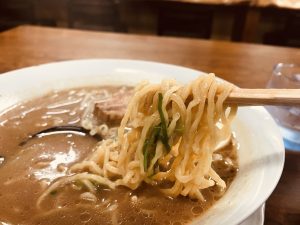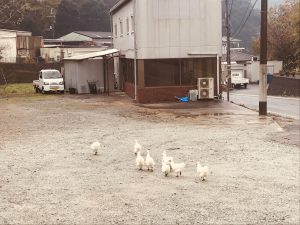
Unlike fruits, vegetables, and many foods in Japan, udon noodles don’t have a season. They are a popular item year round across the country, especially at lunch time, when many shops will be full of people slurping up the soft, white, delicious noodles. It was that slurping that caused my dad to raise his eyebrows when he first came to Japan and ate udon. However, it is actually a way that helps you taste both the noodles and the soup, and enjoy the aroma. Even if it is a little uncomfortable for you, I suggest you try it!
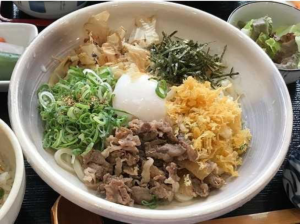
Atop the white noodles, you might find a variety of toppings, like beef, green onions, battered or fried shrimp, pumpkin, sweet potato, pumpkin, or a nest-like combination of sliced carrots and onions. I often order the udon topped with fried tofu, known as “kitsune udon” (fox udon), stemming from the belief that foxes like fried tofu. Regardless of which kind of udon I order, it is always consistently delicious, especially on a cold winter’s day.
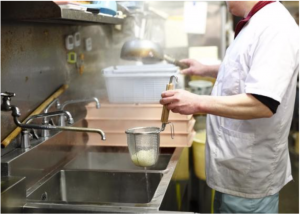
Many people eat udon in shops or buy it at the grocery store, but we have an experience that allows you to try making it from scratch! Feel the dough in your hands, and learn how to make udon like a pro! Totsukawa Udon Komichi uses water from Totsukawa Village, Nara, bringing some of the fresh flavors of the mountains to you in the city. Please feel free to check it out!
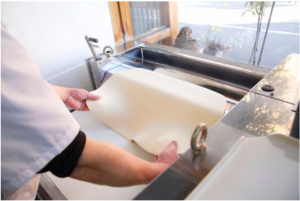

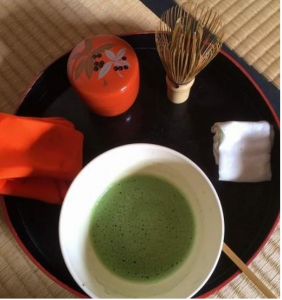 That is why some teachers decide to meet their students half way. By moving the practice to a table top and chairs, students can focus on elements of tea ceremony more important than sitting. Students can learn about the flow, the utensils, and the heart and mind of cha-no-yu. They can learn how the season is reflected in the utensils, decorations, and sweets. They can focus on appreciating the beauty of these items, and the efforts the host must have gone through to prepare them. Doing all this, in a painless way none the less, helps ensure that everyone has a nice time together.
That is why some teachers decide to meet their students half way. By moving the practice to a table top and chairs, students can focus on elements of tea ceremony more important than sitting. Students can learn about the flow, the utensils, and the heart and mind of cha-no-yu. They can learn how the season is reflected in the utensils, decorations, and sweets. They can focus on appreciating the beauty of these items, and the efforts the host must have gone through to prepare them. Doing all this, in a painless way none the less, helps ensure that everyone has a nice time together.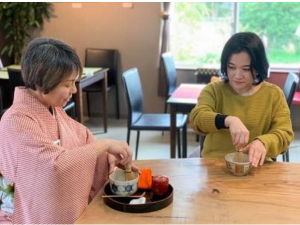 Nara is home to some of the most famous pottery and tea whisks in Japan, and produces lots of tea in its rolling hills, so its connection with tea ceremony goes back to the art’s beginnings. Perhaps one of the ways of keeping this tradition alive and well is to make it more accessible for newcomers, and we have a program that takes a step in that direction. Music Cafe Anges in Kashihara City offers participants the chance to learn about tea ceremony and whisk a bowl themselves in the comfort of a table and a chair. Participants don’t just learn about the process, but also the philosophy of this ancient art. With tea produced in Nara and traditional sweets from a popular local shop, it is a chance to comfortably experience a tea ceremony unique to this place and this time. If you are interested, please check the link below.
Nara is home to some of the most famous pottery and tea whisks in Japan, and produces lots of tea in its rolling hills, so its connection with tea ceremony goes back to the art’s beginnings. Perhaps one of the ways of keeping this tradition alive and well is to make it more accessible for newcomers, and we have a program that takes a step in that direction. Music Cafe Anges in Kashihara City offers participants the chance to learn about tea ceremony and whisk a bowl themselves in the comfort of a table and a chair. Participants don’t just learn about the process, but also the philosophy of this ancient art. With tea produced in Nara and traditional sweets from a popular local shop, it is a chance to comfortably experience a tea ceremony unique to this place and this time. If you are interested, please check the link below.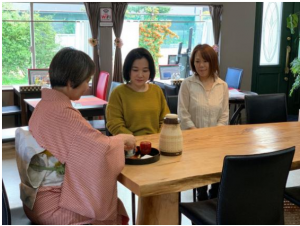
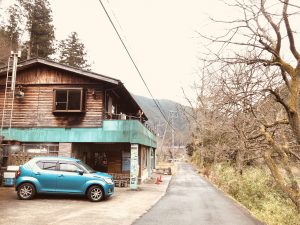

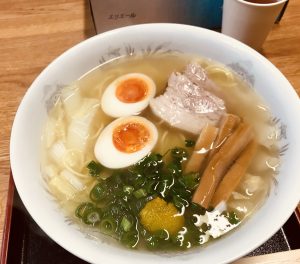
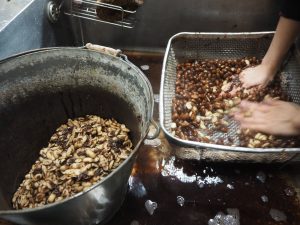 “Yokan” is a Japanese dessert made from mashed beans and gelatin, and often flavored and colored as well. Every winter, Asahikan in Kawakami Village makes its “yuzu yokan” from scratch. They boil the beans in a wood-fire pot, then rinse them and skin them before mashing them up to be used in the dessert. They continue to use a recipe and methods that have been passed down through generations, including picking the yuzu, a citrus fruit, from trees nearby. Flakes of the fruit’s yellow skin add a subtle flavor to the yokan’s sweetness, and a bright element to the already pink-colored dessert.
“Yokan” is a Japanese dessert made from mashed beans and gelatin, and often flavored and colored as well. Every winter, Asahikan in Kawakami Village makes its “yuzu yokan” from scratch. They boil the beans in a wood-fire pot, then rinse them and skin them before mashing them up to be used in the dessert. They continue to use a recipe and methods that have been passed down through generations, including picking the yuzu, a citrus fruit, from trees nearby. Flakes of the fruit’s yellow skin add a subtle flavor to the yokan’s sweetness, and a bright element to the already pink-colored dessert. 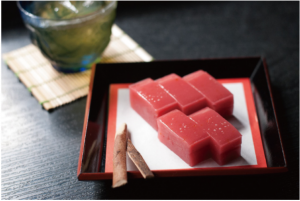 As a 130-year-old traditional Japanese inn, Asahikan offers guests the opportunity to experience what staying in the countryside might have been like in a previous era. With its traditional architecture, including a stunning garden on its second floor, you can walk the same wooden halls and stay in the same tatami rooms as its many visitors have done for over a century.
As a 130-year-old traditional Japanese inn, Asahikan offers guests the opportunity to experience what staying in the countryside might have been like in a previous era. With its traditional architecture, including a stunning garden on its second floor, you can walk the same wooden halls and stay in the same tatami rooms as its many visitors have done for over a century.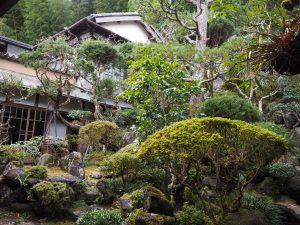 If you are looking for some outdoor fun as well, we offer an experience in which you can stay at Asahikan, chop some bamboo from its mountain grove, and turn that bamboo into your own lunchbox. You’ll take that lunch with you when you go out to explore the wide variety of moss in our village, and then create your own moss terrarium. Young or old, all ages are welcome!
If you are looking for some outdoor fun as well, we offer an experience in which you can stay at Asahikan, chop some bamboo from its mountain grove, and turn that bamboo into your own lunchbox. You’ll take that lunch with you when you go out to explore the wide variety of moss in our village, and then create your own moss terrarium. Young or old, all ages are welcome!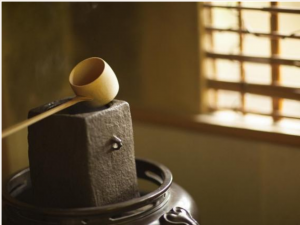
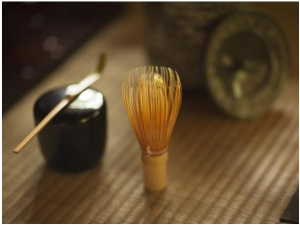
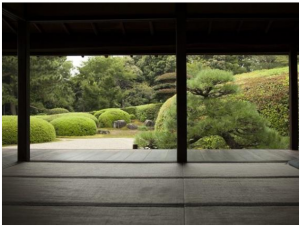
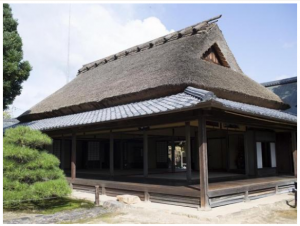
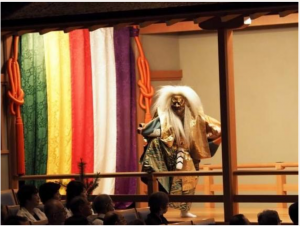 “An empty sky of music, a rain of flowers, strange fragrance on every side; all these are no common things, nor is this cloak that hangs upon the pine tree…”
“An empty sky of music, a rain of flowers, strange fragrance on every side; all these are no common things, nor is this cloak that hangs upon the pine tree…”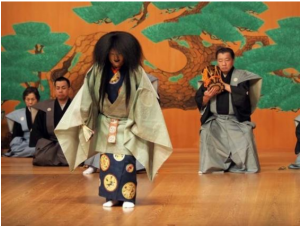 It is a traditional story of an interaction between a fisherman and a Tennin, an aerial spirit or celestial dancer. It takes place in an old world that feels both simpler and more susceptible to visits from aerial spirits.
It is a traditional story of an interaction between a fisherman and a Tennin, an aerial spirit or celestial dancer. It takes place in an old world that feels both simpler and more susceptible to visits from aerial spirits.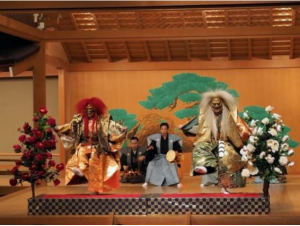 Though most of us just read these stories, visitors to Nara will have the chance to learn and feel the power of Noh and what this story is about. Twice in early February, 2020, a Noh experience and workshop will be held at Kasugano International Forum IRAKA in Nara City. First, participants will have the chance to view a performance and learn about the story, the roles in Noh, and the instruments used in the performance. Then in the workshop, participants can try on some of the costumes and play one of the instruments. It is a rare chance to cross into a world that is usually exclusive to performers and professionals, and feel both the power of this story and the sights, sounds, and textures of the traditional Japanese art.
Though most of us just read these stories, visitors to Nara will have the chance to learn and feel the power of Noh and what this story is about. Twice in early February, 2020, a Noh experience and workshop will be held at Kasugano International Forum IRAKA in Nara City. First, participants will have the chance to view a performance and learn about the story, the roles in Noh, and the instruments used in the performance. Then in the workshop, participants can try on some of the costumes and play one of the instruments. It is a rare chance to cross into a world that is usually exclusive to performers and professionals, and feel both the power of this story and the sights, sounds, and textures of the traditional Japanese art. 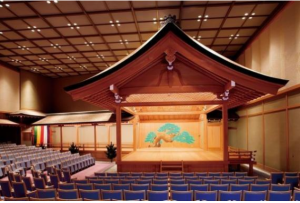
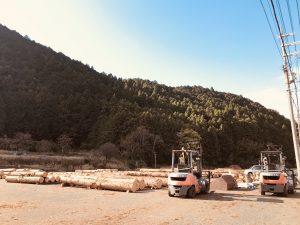 Cafe Le Repos isn’t in the first place you’d expect a cafe to be. A few minutes up the Yoshino River from Kintetsu Yamato-Kamiichi Station, we make a tight right turn to head over the river on the Imosebashi Bridge. After crossing the bridge, we see a lumber auction yard, with dozens of large Yoshino cedar logs lined up. To the left is an auto shop, and it’s in a corner of that auto shop that I found the cozy Cafe Le Repos.
Cafe Le Repos isn’t in the first place you’d expect a cafe to be. A few minutes up the Yoshino River from Kintetsu Yamato-Kamiichi Station, we make a tight right turn to head over the river on the Imosebashi Bridge. After crossing the bridge, we see a lumber auction yard, with dozens of large Yoshino cedar logs lined up. To the left is an auto shop, and it’s in a corner of that auto shop that I found the cozy Cafe Le Repos.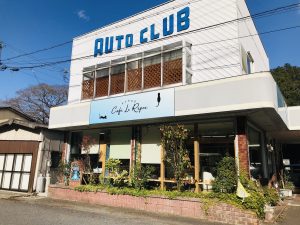 Despite having just opened a few months ago, they were busy with regular customers chatting away at the center table. The inside of the cafe is a beautiful example of how the wood, grown in mountains up the river and gathered as logs outside, can be used to provide a warm and comfortable dining environment. The owner informed me that the day’s special was sold out, so our only option was the keema curry. It was spicy enough to wake me up, while still being incredibly flavorful. My lunch also included a small cup of somen noodles and radish pickles, which served to balance out the spice of the keema curry. When the owner wasn’t busy in the kitchen, she would casually chat with us or the group of regulars at the large table.
Despite having just opened a few months ago, they were busy with regular customers chatting away at the center table. The inside of the cafe is a beautiful example of how the wood, grown in mountains up the river and gathered as logs outside, can be used to provide a warm and comfortable dining environment. The owner informed me that the day’s special was sold out, so our only option was the keema curry. It was spicy enough to wake me up, while still being incredibly flavorful. My lunch also included a small cup of somen noodles and radish pickles, which served to balance out the spice of the keema curry. When the owner wasn’t busy in the kitchen, she would casually chat with us or the group of regulars at the large table.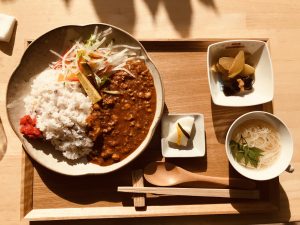 Located near the auction yard, saw mills, and auto shop, Cafe Le Repos seems like it’d be a warm lunch escape for the many people working hard outside in the area. However, I also think it’s worthwhile for visitors to the area to make the journey over the Imosebashi Bridge, across the Yoshino River, and relax in a place a little out of the ordinary. Even if it’s your first visit, I hope you can feel as comfortable as one of the locals.
Located near the auction yard, saw mills, and auto shop, Cafe Le Repos seems like it’d be a warm lunch escape for the many people working hard outside in the area. However, I also think it’s worthwhile for visitors to the area to make the journey over the Imosebashi Bridge, across the Yoshino River, and relax in a place a little out of the ordinary. Even if it’s your first visit, I hope you can feel as comfortable as one of the locals.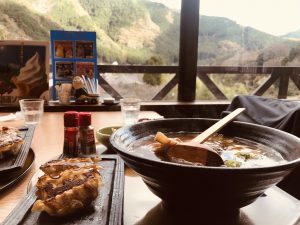 Another term for ramen in Japan is Chuka-men, or “Chinese noodles”. I ordered the Chuka-men combination with gyoza, and enjoyed the great scenery while I waited for my food. Sato offers a wide view of the endless mountains of Yoshino cedar, and the calming Yoshino River running below.
Another term for ramen in Japan is Chuka-men, or “Chinese noodles”. I ordered the Chuka-men combination with gyoza, and enjoyed the great scenery while I waited for my food. Sato offers a wide view of the endless mountains of Yoshino cedar, and the calming Yoshino River running below. 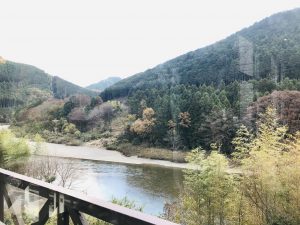 My food eventually arrived on a tray that seemed like it could cover the entire table, and in addition to my noodles and gyoza, included rice, stewed vegetables, and pickles. My bowl of noodles had a soy sauce based broth with slices of pork, half a hard-boiled egg, green onions, and popular Japanese vegetables like napa cabbage and bamboo shoots. The gyoza was perfect! Crispy, flavorful, and huge! After finishing everything on my tray, I wasn’t sure if I’d be able to walk out the door.
My food eventually arrived on a tray that seemed like it could cover the entire table, and in addition to my noodles and gyoza, included rice, stewed vegetables, and pickles. My bowl of noodles had a soy sauce based broth with slices of pork, half a hard-boiled egg, green onions, and popular Japanese vegetables like napa cabbage and bamboo shoots. The gyoza was perfect! Crispy, flavorful, and huge! After finishing everything on my tray, I wasn’t sure if I’d be able to walk out the door.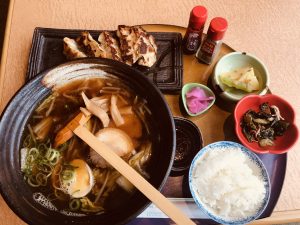 Signed photos and autographs near the entrance show how popular of a stop Sato is among celebrities who pass through. Sato is also a very popular place among the locals, and even with all that fame, the staff always makes an effort to remember faces and names. Even if it is your one and only visit there, I am sure they will welcome you very warmly! As I mentioned, they still have a giant menu, so I recommend going there multiple times and trying something new every time.
Signed photos and autographs near the entrance show how popular of a stop Sato is among celebrities who pass through. Sato is also a very popular place among the locals, and even with all that fame, the staff always makes an effort to remember faces and names. Even if it is your one and only visit there, I am sure they will welcome you very warmly! As I mentioned, they still have a giant menu, so I recommend going there multiple times and trying something new every time.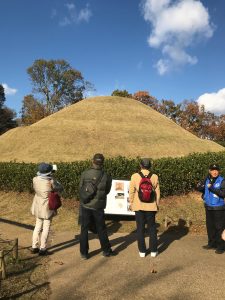
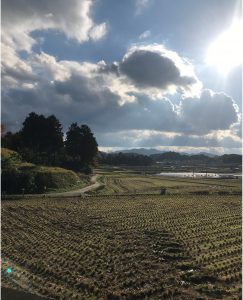
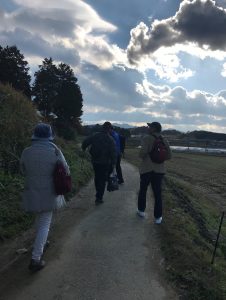
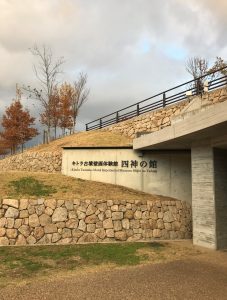 I arrived at Kitora Tomb and first headed to the Shijin-no-yakata in the Center for Preservation of Kitora Tumulus Mural Paintings.
I arrived at Kitora Tomb and first headed to the Shijin-no-yakata in the Center for Preservation of Kitora Tumulus Mural Paintings.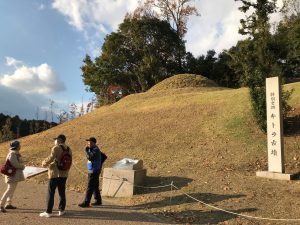
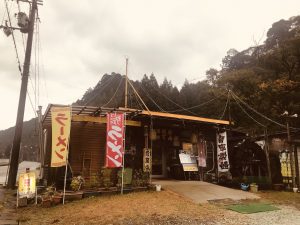 Or at least, that’s how it feels when I visit Yottenka in Yoshino Town. It’s a small, stand-alone wooden shop, attached to old truck beds, and with a wooden water wheel in front. Inside is the kind of warm atmosphere that is difficult for visitors to Japan to discover on their own. Shelves of comic books, a box of local fruit, a counter facing the kitchen, and a well-worn center table. In addition to standard flavors like miso, soy sauce, and salt ramen, they have a special sesame ramen, a spicy beansprout ramen, and even chilled ramen for hot summer days.
Or at least, that’s how it feels when I visit Yottenka in Yoshino Town. It’s a small, stand-alone wooden shop, attached to old truck beds, and with a wooden water wheel in front. Inside is the kind of warm atmosphere that is difficult for visitors to Japan to discover on their own. Shelves of comic books, a box of local fruit, a counter facing the kitchen, and a well-worn center table. In addition to standard flavors like miso, soy sauce, and salt ramen, they have a special sesame ramen, a spicy beansprout ramen, and even chilled ramen for hot summer days.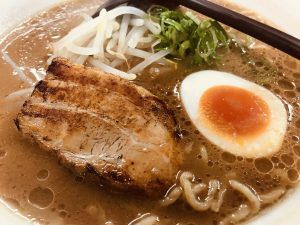 When I went there for lunch the other day, I ordered the miso ramen and gyoza set. The noodles seemed to absorb the flavorful miso soup, as did the slice of pork, which slowly softened as I saved it for last. The gyoza came out hot and fresh, smelling of garlic as I dipped each bite into the spicy red oil. I said “gochisosama” to kind old man and exited the shop with a full stomach.
When I went there for lunch the other day, I ordered the miso ramen and gyoza set. The noodles seemed to absorb the flavorful miso soup, as did the slice of pork, which slowly softened as I saved it for last. The gyoza came out hot and fresh, smelling of garlic as I dipped each bite into the spicy red oil. I said “gochisosama” to kind old man and exited the shop with a full stomach. 